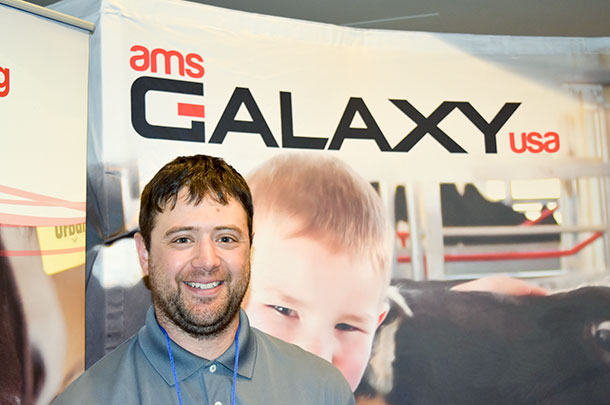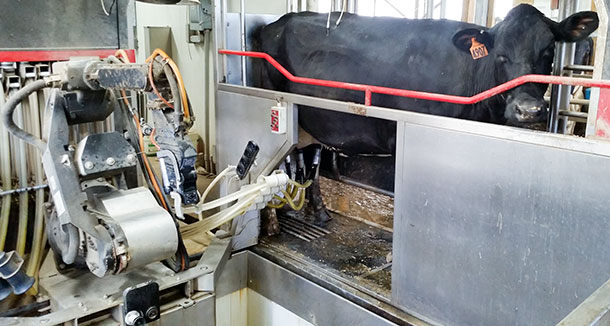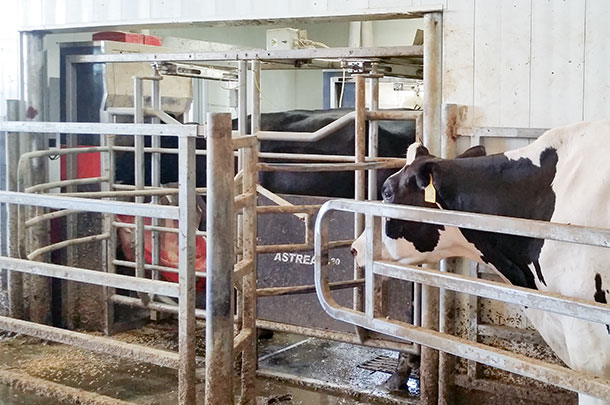At the recent Precision Dairy Conference, Jason Troyer of RJT Dairy Farm in Centerville, Pennsylvania, spoke about his experience transitioning from milking 150 cows in a double-four parlor to milking 215 cows in a robotic milking system.
RJT Dairy is owned and operated by Jason, his sister Rachael and his parents, Janet and Ron Troyer. The dairy was established in 1978 when the family moved from Ohio, bought cows and began milking. During the herd buyout in 1985, the cows were sold, but in the spring of 1992, 50 cows were purchased and they were back in the dairy business again.
After college, Jason returned to the farm in 2007, and the family knew at this time they would have to make some changes to the facilities and update the parlor in order to keep Jason working on the farm. They began researching barns and parlors. In 2009, they built a new barn, and by 2015 they had grown the herd to 150 milking cows. During this time, Jason was doing some of the milkings, and even though he was only in his mid-20s, he was beginning to feel the wear and tear on his knees. After much discussion and research, the family decided to forego a new parlor and chose to install two robots. The reason for the precision dairy transition was they were milking 150 cows twice a day in a double-four herringbone parlor. Pushing 150 cows through was taking six hours each milking, for a total daily milking time of 12 hours. They had three full-time employees and one part-time employee along with the family.

In 2015, when they decided to transition to precision dairy farming, the Troyers added 72 feet onto the front of their new barn to accommodate the robots and 100 feet onto the back of the barn for their dry cows and heifers. Today, there are 260 sand-bedded freestalls in the four-row barn for the milking cows. Currently, the robots are milking 220 cows. They have four milking boxes and two arms. The robots milk 24 hours a day, and they have one full-time employee and one part-time employee as well as the family labor. Today they are milking more cows and getting more milk with less hired labor than before installing the robots. The transition to precision dairy farming provides increased profits by utilizing better management tools and an improved quality of life for both the cows and the family.
Some of the features used on a daily basis are a milking system app and cow management software, which allow access and control of the robot and send individual cow alert text messages. Jason Troyer stated he liked the durability of the arm, the steam cleaner for sanitation of teat cups between milkings, the superior teat preparation and the low-maintenance cost attributed to the weeklong training with his technician that allows him to do the preventative maintenance the robot requires.

According to Troyer, there are essential management practices to ensure a successful transition to precision dairy farming. He listed the following guidelines:
- Ensure the PMR (partial mixed ration) is accurate to support good cow traffic and high production.
- Attend farmer technical training.
- Make daily observations of the equipment.
- Have a preventative maintenance program.
- Make hoof health a priority.
- Have a heifer training protocol.
- Have an A.I. program that focuses on teat placement, milking speed and feet and legs.
When transitioning to robots during the start-up phase, it is critical to be patient with the cows and have a good support system. Your relationship with your equipment dealer is paramount to your success as a precision dairy farmer.
“We went cold turkey,” Troyer said. “In the morning, we milked in the parlor, and in the afternoon, we began milking the cows in the robot.”

The first milking they attached the milkers manually and the second milking they started attaching the milkers with the arm. According to Troyer, there was noticeable improvement every day and by the end of the first week, many of the cows were entering the robots on their own and attaching. During the start-up phase, Troyer said a key indicator that helps to ease the transition is having a person, or people, in the barn who understands the cattle and keeps them clean. Also, having someone with the ability to do some maintenance on the robot is essential. He said you must be patient, be open to changing your routine, be willing to observe and learn new things, keep the stalls and the udders clean, and be proactive about maintenance. Troyer said, “The worst thing is to have a robot that is not milking.”
The benefits of implementing precision dairy farming realized by the Troyer family include the following: the elimination of hiring someone to do the milking, improved health of the people and the cows, less time in the barn and more time with the family, lower feed costs due to the individual feeding in the robot, the highest production attained on the farm and the highest profits obtained on the farm.
“You must always think things through and ask questions,” Troyer said. “Be diligent, and always be looking for ways to improve. Tour farms and learn what works for them may or may not work for you. Be comfortable with who you are as a farmer, and know what works for your operation.” ![]()
Jointly hosted by the University of Kentucky and the University of Minnesota, the Conference on Precision Dairy Farming was held in Lexington, Kentucky, May 30-June 1. Precision technology brings more tools than ever before to the dairyman’s toolbox. Data management, precision feeding, automatic milking, inline sensors and wearable and stand-alone monitors allow for individual, precise, real-time management at the individual cow level.

-
Somula Schwoeppe
- Dairy Producer and Freelance Writer
- Huntingburg, Indiana
- Email Somula Schwoeppe
PHOTO 1: Jason Troyer says a key to making robotic milking successful is keeping the udders and stalls clean. Photo provided by Jason Troyer.
PHOTO 2: During the Precision Dairy Conference, Jason Troyer answered questions based on his experience and expertise with the implementation of precision dairy in the AMS Galaxy booth. Photo by Somula Schwoeppe.
PHOTO 3: The Troyers went “cold turkey” when transitioning the herd to robotic milkers. Photo provided by Jason Troyer.
PHOTO 4: Jason Troyer says his family has seen lower feed costs due to the individualized feeding in the robot. Photo provided by Jason Troyer.






